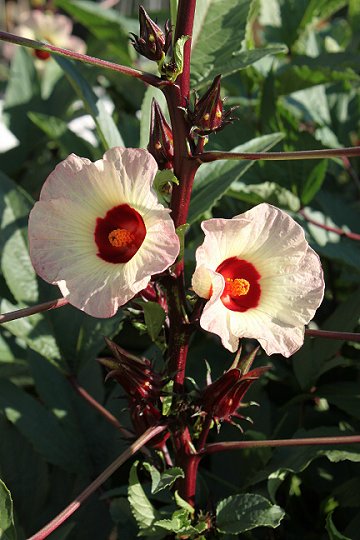
|
|
lRoselle (Hibiscus sabdariffa).
Flowers and fruits.
|
Roselle - Hibiscus
sabdariffa
Roselle (Hibiscus sabdariffa) is a species of Hibiscus (family Malvaceae) native to West
Africa, used for the production of bast fibre and as an infusion, in which it may also be known as
carcade.
It is an annual or perennial herb or woody-based, mostly
branched subshrub. Stems reddish in colour and up to 2–3.5 m (7–10 ft)
tall, with a deep penetrating
taproot.
Leaves variously colored, dark green to red; leaves alternate, glabrous, long-petiolate, palmately divided into 3-7
lobes, with serrate margins.
It is in flower from Aug to October. The flowers are hermaphrodite
(have both male and female organs) and are pollinated by Insects. The species hybridizes with Hibiscus
cannabinus. The flowers are 8–10 cm (3–4 in) in diameter, white to pale yellow with a dark red spot at the base of each
petal, and have a stout fleshy calyx at the base, 1–2 cm (0.39–0.79 in) wide, enlarging to 3–3.5 cm (1.2–1.4
in), fleshy and bright red as the fruit matures. It takes about six months to
mature. Roselle plants exhibit marked photoperiodism, not flowering at short days of 13.5
hours, but flowering at 11 hours. In the United States plants do not flower until short days of late fall or early
winter.
True roselle is Hibiscus sabdariffa L. and there are 2 main types. The more important economically is H. sabdariffa
var. altissima Wester, an erect, sparsely-branched annual to 16 ft (4.8 m) high, which is cultivated for its
jute-like fiber in India, the East Indies, Nigeria and to some extent in tropical
America. The stems of this variety are green or red and the leaves are green, sometimes with red
veins. Its flowers are yellow and calyces red or green, non-fleshy, spiny and not used for
food. This type at times has been confused with kenaf, H. cannabinus L., a somewhat similar but more widely exploited fiber
source.
In some places, the plant is primarily cultivated for the production of bast fibre from the stem of the
plant.
A strong fibre obtained from the stem (called rosella hemp) The fibre may be used as a substitute for jute in making
burlap for various household purposes including making sackcloth, twine and cord. A yellow dye is obtained from the
petals. It is used in medicines etc. The seed yields 20% oil.
The fresh calyx (the outer whorl of the flower) is eaten raw in salads, is cooked and used as a flavouring in cakes etc and is also used in making
jellies, soups, sauces, pickles, puddings etc. The calyx is rich in citric acid and pectin and so is useful for making
jams, jellies etc. It is also used to add a red colour and to flavour to herb
teas, and can be roasted and used as a coffee substitute. A refreshing and very popular beverage can be made by boiling the
calyx, sweetening it with sugar and adding ginger.
Tender young leaves and stems - raw or cooked. Used in salads, as a potherb and as a seasoning in
curries, they have an acid, rhubarb-like flavour.
Seed - roasted and ground into a powder then used in oily soups and sauces. The roasted seeds have been used as a coffee substitute that is said to have aphrodisiac
properties.
Root - it is edible but very fibrousy. Mucilaginous, without very much flavour. The seed yields 20%
oil. (This is probably edible).
The red calyces of the plant are increasingly exported to the United States and
Europe, where they are used as food colourings. Germany is the main importer. It can also be found in markets
(as flowers or syrup) in some places such as France, where there are Senegalese immigrant
communities. The green leaves are used like a spicy version of spinach. They give flavour to the Senegalese fish and rice dish
thieboudienne. Also in Burma their green leaves are the main ingredient in making chin baung kyaw
curry.
The plant is considered to have antihypertensive properties. Hibiscus, specifically
roselle, has been used in folk medicine as a diuretic, and mild laxative.
The famous Hibiscus tea is a herbal tea made as an infusion from crimson or deep
magenta-coloured calyces (sepals) of the roselle (Hibiscus sabdariffa) flower. It is consumed both hot and
cold.
In East Africa, the calyx infusion, called "Sudan tea", is taken to relieve
coughs. Roselle juice, with salt, pepper, asafoetida and molasses, is taken as a remedy for
biliousness.
The heated leaves are applied to cracks in the feet and on boils and ulcers to speed
maturation. A lotion made from leaves is used on sores and wounds. The seeds are said to be diuretic and tonic in action and the
brownish-yellow seed oil is claimed to heal sores on camels. In India, a decoction of the seeds is given to relieve
dysuria, strangury and mild cases of dyspepsia. Brazilians attribute stomachic, emollient and resolutive properties to the bitter
roots.
Although roselle has well documented hypotensive effects, Hibiscus has one of the highest levels of antioxidants of any widely available
food; antioxidants have been shown in several studies to enhance nitric oxide production in the
body, reducing blood pressure and oxidized lipids. Antioxidants have also reduced cancer promotion in several
studies, and plants containing large amounts of antioxidants are regularly studied for their known
anti-cancer effects, and promotion of good health by enabling oxidative
balance.
Source:
https://en.wikipedia.org/wiki/Roselle_(plant)
http://www.pfaf.org/user/Plant.aspx?LatinName=Hibiscus+sabdariffa
https://www.hort.purdue.edu/newcrop/morton/roselle.html
http://www.worldagroforestry.org/treedb/AFTPDFS/Hibiscus_sabdariffa.PDF
